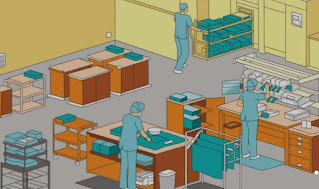Anthelminthics
ANTI-HELMINTHICS
Description also available in video
format (attached below), for better experience use your desktop.
Introduction
· Anti-helminthics are
a class of drugs used to treat infections caused by helminths (parasitic
worms).
· These worms can
infect various parts of the body, including the intestines, liver, blood, and
other tissues, leading to a range of health problems.
· Anti-helminthics are
essential in both human and veterinary medicine to control and eliminate
helminth infections.
Definition
· Anti-helminthics are
medications designed to eradicate or expel parasitic worms (helminths) from the
host's body.
· They work by either
killing the worms directly or expelling them from the host's body through
various mechanisms.
Classification
1.
Benzimidazoles:
o
Examples: Albendazole, Mebendazole,
Thiabendazole
o
Uses: Effective against a broad spectrum of
helminths, including roundworms, hookworms, whipworms, and some tapeworms.
2.
Avermectins:
o
Examples: Ivermectin
o
Uses: Primarily used for treating
strongyloidiasis, onchocerciasis (river blindness), and lymphatic filariasis.
3.
Praziquantel:
o
Examples: Praziquantel
o
Uses: Effective against schistosomiasis and
other fluke infections, as well as certain tapeworm infections.
4.
Pyrantel Pamoate:
o
Examples: Pyrantel
o
Uses: Primarily used for treating pinworm,
roundworm, and hookworm infections.
5.
Diethylcarbamazine (DEC):
o
Examples: Diethylcarbamazine
o
Uses: Used to treat lymphatic filariasis
and loiasis.
Pharmacokinetics
·
Absorption: Some anti-helminthics are
well-absorbed from the gastrointestinal tract, while others have poor
absorption and work locally in the intestines.
·
Distribution: After absorption, these drugs are
distributed throughout the body, although some may preferentially concentrate
in certain tissues.
·
Metabolism: Many anti-helminthics are metabolized
in the liver to active or inactive metabolites.
·
Excretion: The primary route of excretion for
many anti-helminthics is through the bile and feces, although some are also
excreted in the urine.
Mechanism of Action
·
Inhibition of tubulin polymerization (e.g.,
Benzimidazoles): This prevents the formation of microtubules, which are
essential for cellular processes in the parasite.
·
Increasing cell membrane permeability to calcium
ions (e.g., Praziquantel): This leads to muscle contraction and paralysis of
the worm.
·
Inhibition of glutamate-gated chloride channels (e.g., Ivermectin):
This results in paralysis and death of the parasite.
·
Neuromuscular blockade (e.g., Pyrantel
Pamoate): This causes paralysis of the worm, which is then expelled from the
host's body.
Uses
·
Ascariasis (roundworm)
·
Enterobiasis (pinworm)
·
Hookworm infections
·
Strongyloidiasis
·
Trichuriasis (whipworm)
·
Schistosomiasis
·
Tapeworm infections (e.g., Taeniasis, Cysticercosis)
·
Filariasis
·
Onchocerciasis (river blindness)
·
Liver fluke infections
Adverse Effects
·
Hepatotoxicity
·
Neurotoxicity
·
Hematologic abnormalities (e.g., leukopenia)
Contraindications
·
Hypersensitivity to the drug or its components
·
Pregnancy (certain antihelminthics)
·
Liver disease
·
Severe malnutrition
Role of Nurse
1.
Assessment:
o
Obtain a thorough patient history, including potential exposure to
helminths, symptoms, and any previous treatments.
o
Monitor for signs and symptoms of helminth infections and assess the
severity of the infection.
2.
Administration:
o
Ensure correct dosing and timing of medication administration.
o
Educate patients on how to take the medication properly, including
whether it should be taken with food or on an empty stomach.
3.
Monitoring:
o
Monitor for therapeutic effects and improvement in symptoms.
o
Observe for adverse effects and manage them appropriately.
o
Monitor liver function tests and other relevant laboratory parameters as
indicated.
4.
Patient Education:
o
Educate patients on the importance of completing the full course of
therapy.
o
Provide information on preventive measures to avoid reinfection, such as
proper hygiene and sanitation practices.
o
Advise on potential side effects and when to seek medical attention.
5.
Follow-up:
o
Schedule follow-up appointments to assess the effectiveness of treatment
and ensure the infection has been eradicated.
o
Reinforce preventive measures to reduce the risk of reinfection.
Video Description
· Don’t forget to do these things if
you get benefitted from this article
o Visit our Let’s
contribute page https://keedainformation.blogspot.com/p/lets-contribute.html
o Follow our page
o Like & comment on our post
·




Comments